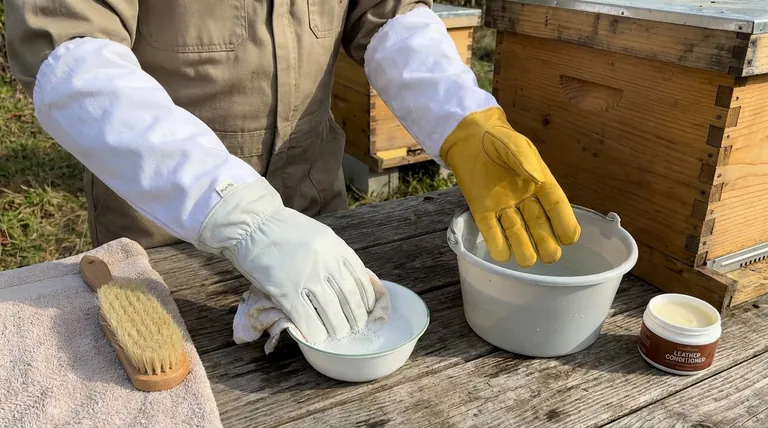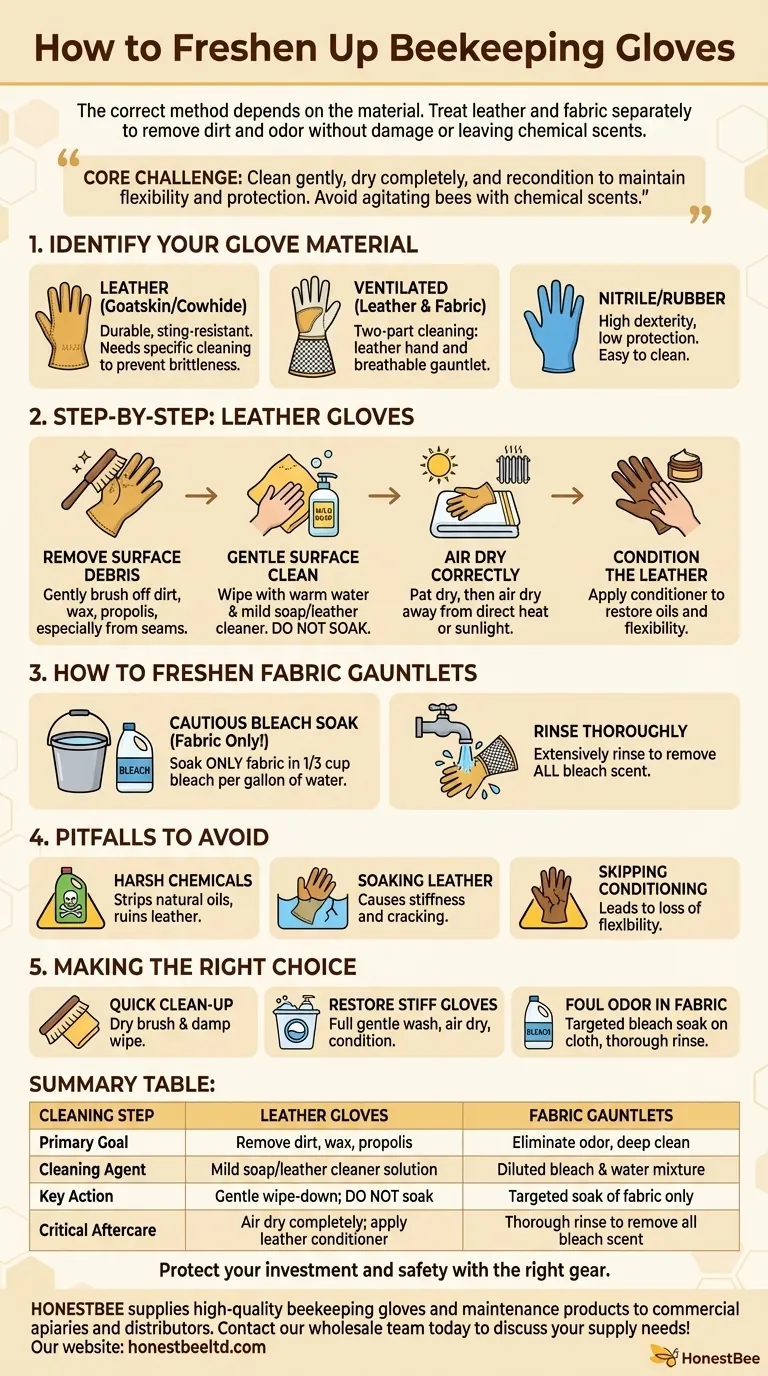To freshen up your beekeeping gloves, the correct method depends entirely on the material. For common leather gloves with fabric gauntlets, you must treat each part separately: gently wipe the leather with a mild soap solution without soaking it, and for the fabric portion, you can use a cautious soak in a mild bleach and water mixture, followed by a very thorough rinse.
The core challenge in freshening beekeeping gloves is removing dirt and odor without damaging the leather or leaving behind chemical scents that could agitate your bees. The key is to clean gently, dry completely, and always recondition the leather to maintain its flexibility and protective qualities.

First, Identify Your Glove Material
Before you begin cleaning, it's essential to know what your gloves are made of, as this dictates the entire process.
Leather Gloves (Goatskin or Cowhide)
These are the most common type, valued for their durability and sting resistance. Goatskin is more supple and offers greater dexterity, while cowhide provides maximum protection but can be stiffer. Both require a specific cleaning process to prevent them from becoming brittle.
Ventilated Gloves (Leather & Fabric)
Many gloves feature a leather hand and a breathable fabric or mesh gauntlet that extends up the arm. These require a two-part cleaning approach to handle the different materials correctly.
Nitrile or Rubber Gloves
These gloves offer the highest dexterity and are easy to clean but provide minimal sting protection. They are best for tasks that don't involve direct handling of frames full of bees.
The Step-by-Step Process for Leather Gloves
This method preserves the integrity of the leather while removing dirt, wax, and propolis.
Step 1: Remove Surface Debris
Use a soft brush to gently remove all loose dirt, dried wax, and propolis from the surface of the gloves. Pay close attention to the seams and crevices where debris can accumulate.
Step 2: Perform a Gentle Surface Clean
Prepare a solution of warm water and a small amount of mild soap or a dedicated leather cleaner. Dampen a soft cloth with the solution, wring it out well, and gently wipe down the leather.
The goal is to clean the surface, not to soak the leather. Excessive water will cause the leather to become stiff and brittle once it dries.
Step 3: Dry the Gloves Correctly
Pat the gloves with a clean, dry towel to absorb any excess moisture. Allow them to air dry completely at room temperature, away from direct sunlight or heat sources like a radiator, which can cause the leather to crack.
Step 4: Condition the Leather
Once the gloves are fully dry, apply a small amount of leather conditioner. This crucial step restores the oils that were stripped during cleaning, keeping the gloves supple, flexible, and comfortable.
How to Freshen Fabric Gauntlets
If your gloves have fabric gauntlets that are particularly dirty or odorous, you can clean them more aggressively, but with extreme care.
The Cautious Bleach Soak
You can soak the cloth portion only in a mixture of 1/3 cup of bleach per gallon of water. Submerge only the fabric, keeping the leather hand completely out of the solution.
Rinse Thoroughly
After a brief soak, you must rinse the fabric gauntlets extensively with clean water. Any lingering bleach scent can be highly disruptive and agitating to your bees.
Understanding the Pitfalls and Risks
Avoiding common mistakes is just as important as following the right steps.
The Danger of Harsh Chemicals
Never use general household cleaners or bleach directly on leather. These products will strip the natural oils, causing the leather to dry out, become brittle, and lose its protective qualities.
Why You Must Not Soak Leather
Saturating leather with water and then letting it dry fundamentally changes its fibrous structure. This is what leads to the stiffness and cracking that ruins a good pair of gloves.
Forgetting to Condition
Skipping the conditioning step is the most common mistake. Cleaning removes oils, and if they aren't replaced, the gloves will lose the very flexibility you need to work efficiently in the hive.
Making the Right Choice for Your Goal
Select your cleaning method based on the specific issue you need to solve.
- If your primary focus is a quick clean-up after inspection: A simple dry brushing and a wipe-down of the leather with a damp cloth is all you need.
- If your goal is to restore stiff, dirty leather gloves: Commit to the full gentle wash and air-dry process, and be generous but even with the leather conditioner.
- If your main problem is a foul odor in the fabric gauntlets: Carefully use the targeted bleach soak on the cloth portion only, followed by an extremely thorough rinse to remove all traces of scent.
Properly maintaining your gloves not only extends their life but also ensures your safety and confidence with every hive inspection.
Summary Table:
| Cleaning Step | Leather Gloves | Fabric Gauntlets |
|---|---|---|
| Primary Goal | Remove dirt, wax, propolis | Eliminate odor, deep clean |
| Cleaning Agent | Mild soap/leather cleaner solution | Diluted bleach & water mixture |
| Key Action | Gentle wipe-down; DO NOT soak | Targeted soak of fabric only |
| Critical Aftercare | Air dry completely; apply leather conditioner | Thorough rinse to remove all bleach scent |
Protect your investment and your safety with the right gear. Properly maintained gloves are essential for effective beekeeping. At HONESTBEE, we supply high-quality beekeeping gloves and maintenance products to commercial apiaries and distributors. Let us help you equip your operation with durable, easy-to-clean gear that lasts. Contact our wholesale team today to discuss your supply needs!
Visual Guide

Related Products
- Beekeeping Gloves Goatskin Leather with Long Cotton Sleeve for Beekeepers
- Goatskin Leather Beekeeper Gloves with Vent Long Sleeve for Beekeeping Honey Bee Sting Proof Protection
- Goat Skin Leather Bee Sting Proof Beekeeping Gloves with Canvas Sleeve
- Mesh Ventilated 3 Layer Goatskin Beekeepers Gloves for Beekeeping
- Professional Galvanized Hive Strap with Secure Locking Buckle for Beekeeping
People Also Ask
- What are the features of ventilated bee gloves? Stay Cool & Dexterous in Warm Weather
- What are the advantages of goatskin leather gloves for beekeeping? Superior Sting Protection for Your Apiary
- Why is dexterity and flexibility important in beekeeping gloves? Boost Your Hive Management Efficiency
- What is the safest way to handle frames in beekeeping? Master Gentle Handling for a Calm Hive
- What is the difference between cleaning cow leather and goat leather beekeeping gloves? Tailor Your Care for Longevity



















